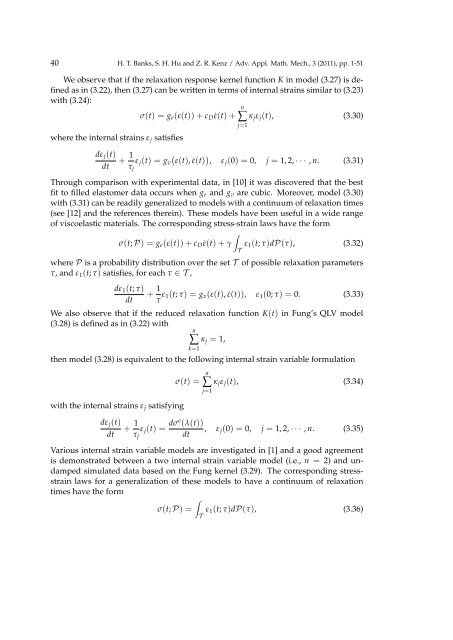A Brief Review of Elasticity and Viscoelasticity for Solids 1 Introduction
A Brief Review of Elasticity and Viscoelasticity for Solids 1 Introduction
A Brief Review of Elasticity and Viscoelasticity for Solids 1 Introduction
Create successful ePaper yourself
Turn your PDF publications into a flip-book with our unique Google optimized e-Paper software.
40 H. T. Banks, S. H. Hu <strong>and</strong> Z. R. Kenz / Adv. Appl. Math. Mech., 3 (2011), pp. 1-51<br />
We observe that if the relaxation response kernel function K in model (3.27) is defined<br />
as in (3.22), then (3.27) can be written in terms <strong>of</strong> internal strains similar to (3.23)<br />
with (3.24):<br />
n<br />
σ(t) = g e (ε(t)) + c D ˙ε(t) + ∑ κ j ε j (t), (3.30)<br />
j=1<br />
where the internal strains ε j satisfies<br />
dε j (t)<br />
+ 1 ( )<br />
ε j (t) = g v ε(t), ˙ε(t) , ε j (0) = 0, j = 1, 2, · · · , n. (3.31)<br />
dt τ j<br />
Through comparison with experimental data, in [10] it was discovered that the best<br />
fit to filled elastomer data occurs when g e <strong>and</strong> g v are cubic. Moreover, model (3.30)<br />
with (3.31) can be readily generalized to models with a continuum <strong>of</strong> relaxation times<br />
(see [12] <strong>and</strong> the references therein). These models have been useful in a wide range<br />
<strong>of</strong> viscoelastic materials. The corresponding stress-strain laws have the <strong>for</strong>m<br />
∫<br />
σ(t; P) = g e (ε(t)) + c D ˙ε(t) + γ ε 1 (t; τ)dP(τ), (3.32)<br />
where P is a probability distribution over the set T <strong>of</strong> possible relaxation parameters<br />
τ, <strong>and</strong> ε 1 (t; τ) satisfies, <strong>for</strong> each τ ∈ T ,<br />
dε 1 (t; τ)<br />
dt<br />
T<br />
+ 1 τ ε 1(t; τ) = g v (ε(t), ˙ε(t)), ε 1 (0; τ) = 0. (3.33)<br />
We also observe that if the reduced relaxation function K(t) in Fung’s QLV model<br />
(3.28) is defined as in (3.22) with<br />
n<br />
κ j = 1,<br />
∑<br />
k=1<br />
then model (3.28) is equivalent to the following internal strain variable <strong>for</strong>mulation<br />
with the internal strains ε j satisfying<br />
dε j (t)<br />
dt<br />
σ(t) =<br />
n<br />
∑ κ j ε j (t), (3.34)<br />
j=1<br />
+ 1 ε j (t) = dσe (λ(t))<br />
, ε j (0) = 0, j = 1, 2, · · · , n. (3.35)<br />
τ j dt<br />
Various internal strain variable models are investigated in [1] <strong>and</strong> a good agreement<br />
is demonstrated between a two internal strain variable model (i.e., n = 2) <strong>and</strong> undamped<br />
simulated data based on the Fung kernel (3.29). The corresponding stressstrain<br />
laws <strong>for</strong> a generalization <strong>of</strong> these models to have a continuum <strong>of</strong> relaxation<br />
times have the <strong>for</strong>m<br />
∫<br />
σ(t; P) = ε 1 (t; τ)dP(τ), (3.36)<br />
T

















